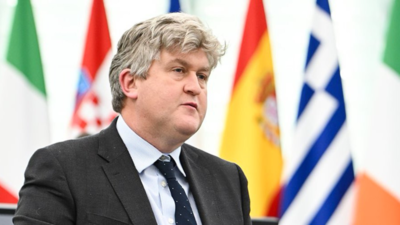- News
- Business News
- India Business News
- India must decide its approach based on its unique needs: Michael McNamara
Trending
India must decide its approach based on its unique needs: Michael McNamara
The regulatory balance India strikes will shape its AI-driven economy
New Delhi: As India gears up to frame its own AI regulations, and policymakers are looking at a balanced approach that fosters innovation while ensuring ethical, and transparent AI growth, Michael McNamara, member of the European parliament and co-chair of the European parliament on AI in an exclusive conversation with the TOI shares insights on global AI governance, media transformation, and the challenges of regulating AI without stifling innovation. The Irish independent politician also spoke of the European Union’s landmark AI Act, its implications, and the lessons India can draw from Europe’s regulatory experience. Excerpts of the interview.
The EU has set a global benchmark with the AI Act. What were the key challenges in framing this legislation, and how were they overcome?
The key challenge was balancing risk mitigation with allowing businesses to innovate. AI adoption varies significantly across regions — China leads with nearly 70% uptake, followed by the US, while Europe lags. This impacts competitiveness, as highlighted in the Draghi (former European Central Bank President Mario Draghi) report on European industrial progress. The AI Act aims to safeguard society from risks while promoting AI adoption. However, the process remains ongoing, with four working groups refining the third draft. At the AI summit in Paris, differences between regulatory approaches — Europe’s cautious stance versus the US’s hands-off approach — became evident. Some policymakers argue that no regulation is necessary, while Europe insists on safeguards.
What takeaways from the EU experience would you recommend for Indian policymakers?
AI is transforming journalism and media but also raises concerns about misinformation, deepfakes, and ethical use. How does the EU AI Act address these issues?
The AI Act mandates clear labelling of AI-generated content, including deepfakes. Unlike an outright ban, the Act ensures transparency, enabling audiences to distinguish between real and AI-generated content. The debate over outright prohibition versus disclosure continues, but Europe has opted for disclosure as the best path forward.
How can media organisations ensure fair compensation for original content creators amid the rise of generative AI?
This is a contentious issue in both Europe and India. Copyright holders argue they cannot demand fair compensation if they don’t know whether AI models have used their content. Developers, on the other hand, claim that the vast scope of training data makes full transparency difficult. Europe’s Copyright Act allows data mining for scientific research, but the intersection with generative AI remains unresolved. Lawsuits and policy debates will likely shape future regulations.
What mechanisms has the EU put in place to ensure compliance with the AI Act, particularly for global tech companies?
The EU is developing a Code of Conduct with major AI developers. Some companies are reluctant to sign, but enforcement mechanisms will take effect by August this year. The European Commission and Member States will oversee compliance, with penalties for violations.
India has a large young population and vast digital ecosystem. How should it address the challenge of regulating AI while fostering a thriving startup and innovation culture?
The regulatory balance India strikes will shape its AI-driven economy. Europe regulates AI through its AI Act, while the US largely allows market forces to dictate. India must decide its approach based on its unique needs. Education is another challenge — AI is reshaping learning and assessment. Schools worldwide, including in Ireland, are grappling with how to integrate AI while ensuring academic integrity.
AI governance varies across regions. Do you see potential for international AI standards, or will regulations remain fragmented?
Efforts to create international AI standards are underway through bodies like the OECD (Organisation for Economic Co-operation and Development) and the Council of Europe. However, stark differences persist. Some advocate for minimal regulation, fearing it will hinder innovation, while others, like Europe, prioritise risk mitigation. The challenge lies in balancing innovation with regulation without stifling progress.
Some argue that stringent regulations stifle AI development. How can regulations protect innovation?
It’s a valid concern. The EU is addressing this by simplifying regulations, especially for SMEs, and investing in AI infrastructure. Europe lags in capital investment and computing power, which affects competitiveness. Simplifying compliance while boosting funding will be key to fostering AI innovation.
End of Article
FOLLOW US ON SOCIAL MEDIA












